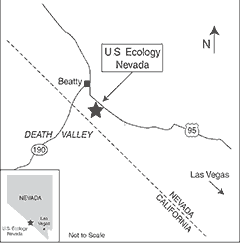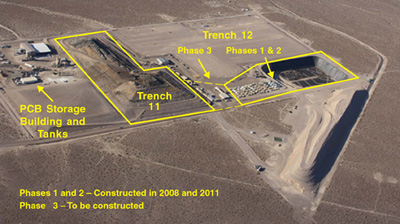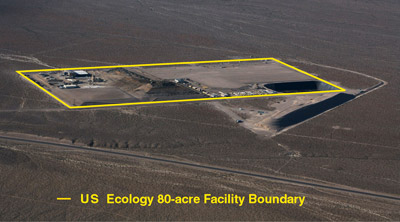Contact EPA Pacific Southwest Cleanup
Pacific Southwest, Region 9
Serving: Arizona, California, Hawaii, Nevada, Pacific Islands, Tribal Nations
US Ecology Nevada, Inc.
On this page:
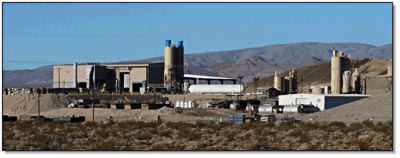
- June 2016 Facility Expansion Approval
- November 2012 Approval
- Renewal Application
- Facility Background
- For More Information
US Ecology Nevada, Inc. ("US Ecology or USEN") is located on a 480-acre site in the Amargosa Desert about 100 miles northwest of Las Vegas, Nevada, off Highway 95. The closest city is Beatty, Nevada, which is located approximately 11 miles northwest of the Facility (see Site Location Map). The US Ecology Facility ("Facility") treats, stores, and disposes of hazardous waste, polychlorinated biphenyls (“PCBs”), and non-hazardous industrial material. The site is owned by the State of Nevada and is operated by US Ecology.
June 2016 Facility Expansion Approval
On June 22, 2016, the U.S. Environmental Protection Agency ("U.S. EPA") approved a modification to the Toxic Substances Control Act ("TSCA") Approval (permit) that allows US Ecology to construct and operate a new 47.3 acre landfill for disposal of PCBs at its hazardous waste management facility located 11 miles outside Beatty, Nevada. A TSCA Approval is essentially a permit. For instance, U.S. EPA follows a similar administrative process for Approval issuance, renewal and modification as a permit.
US Ecology is now operating under an Approval to manage PCB wastes issued by U.S. EPA on November 5, 2012, and modified on June 22, 2016. The Approval authorizes, for the first time, the construction and operation of the Trench 13 landfill for disposal of PCB wastes. The Approval allows continued disposal of PCBs in the Trench 12 landfill, storage of PCBs, and limited treatment for disposal in two batch stabilization tanks. The Approval includes the following PCB Units: Trench 12 Landfill, Trench 13 Landfill, PCB Storage and Processing Building, PCB Tank Farm, Treatment Pans 4 and 5 (batch stabilization tanks), PCB Tank Truck Loading Pad, and the Evaporation Tank.
The modification of the 2012 Approval was subject to a 45-day public comment period that began on April 27, 2016 and ended on June 10, 2016. No comments were received. U.S. EPA's rationale for issuing the Approval and differences between the proposed and final Approval are discussed in U.S. EPA's "PCB Approval Decision" dated June 22, 2016 ("PCB Approval Decision").
For additional information on U.S. EPA's modification to the TSCA Approval, click on the links to the following key documents:
- Permit Fact Sheet (PDF) (4 pp, 486K)
- PCB Approval Decision (PDF) (7 pp, 192K)
- Final Modified Approval (Permit) (PDF) (65 pp, 1.1MB)
- Statement of Basis (PDF) (12 pp, 103KB)
- Administrative Record Index (PDF) (5 pp, 94K)
- TSCA Approval USEN Appendix A (PDF) (7 pp, 117K)
The Following are Large Files
We recommend that you right-click the link and save the file to your desktop or other preferred location. - TSCA Approval USEN Appendix B 1-16 (PDF Portfolio)
(29 pp, 71MB - Very Large File -'Right-Click' the link and 'Save target as') - TSCA Approval USEN Appendix B 17 (PDF Portfolio)
(38 pp, 162MB - Very Large File -'Right-Click' the link and 'Save target as')
November 2012 Approval
On November 5, 2012, EPA issued an Approval (permit) for US Ecology to operate a commercial PCB storage and chemical waste landfill facility (“Facility”). The Approval, which will be valid for ten years, allows US Ecology to continue (1) commercial storage of PCB wastes; (2) treatment of PCB wastes in two stabilization tanks for final disposal; and (3) disposal of PCBs in the Trench 11 landfill. The Approval also authorizes PCB disposal in the Trench 12 landfill which has been receiving hazardous wastes since 2008 under a hazardous waste permit issued by the State of Nevada.
The Approval is being issued pursuant to Section 6(e)(1) of the Toxic Substances Control Act (“TSCA”) of 1976, 15 U.S.C. § 2605(e)(1), and 40 C.F.R. Part 761.
EPA has concluded, based on a thorough review of the record, that this Approval satisfies the TSCA requirements for storage and disposal of PCBs. EPA has also concluded that PCB operations at the Facility do not pose an unreasonable risk of injury to human health or the environment. For more details on EPA's conclusions, see "Requirements Satisfied" section below.
Units Approved for PCB Waste Management
The Approval (“TSCA Approval or Approval”) includes conditions that US Ecology must follow in order to comply with TSCA to safely store, treat, and dispose of PCB wastes at the Beatty, Nevada Facility. For example, conditions in the proposed Approval limit the amount of PCB wastes that can be disposed of in the landfill units.
EPA prepared a Statement of Basis that summarizes the Approval and the rationale for its issuance. In addition, the Statement of Basis documents EPA's determination under the National Historic Preservation Act that historic properties will not be affected by the Approval’s renewal and modification.
The Approval allows US Ecology to:
- Store up to 59,400 gallons of PCB wastes in containers
- Store up to 28,000 gallons of PCB waste in tanks
- Treat for disposal up to 137,000 gallons per day of PCB waste
- Dispose of a maximum of 4.02 million cubic yards of PCB waste in the Trench 11 and Trench 12 landfills. Trench 12 is being constructed in three separate phases. The first phase was constructed in 2008 and the second phase in 2011.
The Approval will also require US Ecology to make the following improvements:
- Construct a new sealed concrete Tank Truck Loading Pad
- Construct new sealed concrete secondary containment for the PCB tank storage area
The Approval authorizes US Ecology to store, treat for disposal, and dispose of PCB wastes at the Facility as described in the table below.
| Waste Management Unit Name | Type and Number of Units | Authorized Activity | Maximum Total Capacity | Location in Approval |
|---|---|---|---|---|
| PCB Storage and Processing Building | 1 Building | Storage | 59,400 gallons | Section V |
| PCB Tank Farm | 5 Tanks | Storage | 28,000 gallons | Section V |
| PCB Tank Truck Loading Pad* | 1 Pad | Waste Transfer | Not Applicable | Section V |
| Stabilization Tanks (a.k.a. “Treatment Pans”) | Treatment Pans 4 and 5 | Treatment for Disposal | 137,000 gallons per day | Section VI |
| Evaporation Tank | 1 Tank | Treatment for Disposal | 10,000 gallons | Section VI |
| Trench 11 | 1 Landfill | Disposal | 2.36 million cubic yards | Section VII |
| Trench 12 | 1 Landfill | Disposal | 1.66 million cubic yards | Section VII |
*The PCB Tank Truck Loading Pad is an ancillary or support unit to the PCB Tank Farm. The Pad, which will be constructed after issuance of the Approval, will provide containment for tanker trucks that receive PCB liquids from the PCB Tank Farm.
For additional information on the units being approved for PCB waste management, see the November 2012 Statement of Basis.
- EPA PCB Approval, US Ecology (PDF) - November 2012 (72 pp, 18.6M)
- Appendices - PCB Approval, US Ecology (ZIP) - November 2012 (43.6M zip file)
- EPA Statement of Basis - PCB Approval, US Ecology (PDF) - November 2012 (91 pp, 13.6M)
Proposed Approval and Public Comments
A Proposed Approval, with a Statement of Basis, was subject to a 45-day public comment period that began on August 10, 2012 and ended on September 24, 2012. On September 13, 2012, EPA conducted an informational public meeting and hearing for the Proposed Approval. EPA received a total of 10 public comments on the Proposed Approval from two commenters.
The public comments, EPA’s response to the comments, changes to the Proposed Approval made as a result of the comments, and U.S. EPA’s rationale for issuing the Approval are included in EPA’s “PCB Approval Decision and Response to Public Comments” document dated November 5, 2012 (“PCB Approval Decision”).
- PCB Approval Decision and Response to Public Comments (PDF) - November 2012 (12 pp, 368K)
Requirements Satisfied
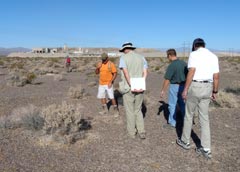
EPA has concluded, based upon review of the administrative record, including reviews of the Renewal Application (1/8/10), Biological Evaluation (2/28/12), Screening Level Ecological Risk Assessment (2/28/12), PCB Surface Soil Sampling Report (9/12/11), and the facility compliance history, that this Approval for US Ecology satisfies the requirements of TSCA and 40 C.F.R. Part 761 for storage of PCBs and for disposal of PCBs in a chemical waste landfill. U.S. EPA has also concluded that PCB operations at the Facility do not pose an unreasonable risk of injury to human health or the environment.
In September 2009, US Ecology conducted a desert tortoise field survey to address endangered species issues and to support the Screening Level Ecological Risk Assessment. No tortoises were found during the survey. In addition, EPA has determined, based on the best scientific and commercial data available, under Section 7 of the Endangered Species Act, that management of PCB wastes at the Facility, as allowed in the Approval, will have no effect on any listed species or designated critical habitat. This includes the desert tortoise, the only federally listed endangered species likely to occur near the Facility. This determination is further discussed in the Statement of Basis (see link below).
The most recent inspection, which was conducted from April 26 to April 28, 2011, showed that there were only minor TSCA violations. Those violations regarded labeling and dating containers that were corrected during the site visit. Therefore, based upon this inspection and other readily available information, the Facility is in compliance with its current Approval and the TSCA PCB regulations at 40 C.F.R. Part 761.
- EPA Endangered Species Act Determination - PCB Approval, US Ecology (PDF) - April, 2012 (3 pp, 900K)
- Biological Evaluation - PCB Approval, US Ecology (PDF) - February, 2012 (87 pp, 5M)
- Screening Level Ecological Risk Assessment - PCB Approval, US Ecology (PDF) - February, 2012 (100 pp, 9M)
- PCB Surface Soil Sampling Report - PCB Approval, US Ecology (PDF) - February 2012 (1592 pp, 36M)
Renewal Application
The Approval is based on the written renewal application titled "Toxic Substances Control Act (TSCA) Permit Renewal Application, US Ecology Nevada, January 8, 2010" as revised on September 24, 2010, February 9, 2011, May 17, 2011 and December 15, 2011 (collectively the "Renewal Application").
US Ecology is currently operating under an Approval to manage PCB wastes issued by U.S. EPA in 1996. On July 1, 2000, US Ecology submitted an application to renew the 1996 Approval prior to its expiration on January 11, 2001. The submittal of the renewal application in 2000 administratively extended the terms of the 1996 Approval. US Ecology's January 8, 2010 Renewal Application seeking a renewal and modification superseded all earlier applications and serves as the basis for this Approval.
EPA previously issued TSCA Approvals to US Ecology in 1978, 1982, 1987, 1989 and 1996 to operate a PCB storage and disposal facility.
- Renewal Application - PCB Approval, US Ecology (ZIP) - January 2010 (24 PDFs in an 85M .zip file)
Facility Background
The 80 acre Facility was established in 1962 by the Nuclear Engineering Company for disposal of low-level radioactive wastes (“LLRW”). In 1970, Nuclear Engineering Company obtained permission from the State of Nevada to dispose of hazardous chemical wastes on a portion of the property adjacent to the authorized LLRW disposal area, but separated by a 200-foot buffer zone. The chemical disposal facility has been in operation since 1970. The disposal of LLRW was discontinued in December 1992.
The Facility consists of nine pre-RCRA chemical waste trenches (closed), one LLRW landfill (closed), and three hazardous waste landfills called Trench 10 (closed), Trench 11 (operating) and Trench 12 (operating).
Other operations at the US Ecology Facility include: Storage of PCBs in containers, batch stabilization and solidification, PCB storage in tanks, and storage of hazardous waste and PCBs.
For More Information
Contact Information
Ronald Leach, Project Manager
(leach.ronald@epa.gov)
U.S. EPA, WST-4
75 Hawthorne Street
San Francisco, CA 94105
(415) 972-3362
FAX: (415) 947-3530
You may read EPA’s fact sheet announcing the issuance of the TSCA Approval to US Ecology and other related fact sheets and notices (see links below).
- EPA Fact Sheet - PCB Approval, US Ecology (PDF) - November 2012 (2 pp, 139K)
- EPA Fact Sheet - Proposed PCB Approval, US Ecology (PDF) - August 2012 (2 pp, 291K)
- EPA Public Notice - Proposed PCB Approval, US Ecology (PDF) - August 2012 (1 pp, 57K)
- EPA News Brief - Proposed PCB Approval, US Ecology (PDF) - August 2012 (1 pp, 57K)
You may also review the Administrative Record (“AR”) which contains the documents and information that EPA considered in issuing the US Ecology Approval. The AR is physically located at the EPA Region 9 Office in San Francisco, California. An index of the AR is here: EPA Administrative Record Index - PCB Approval, US Ecology (PDF) - November 2012 (12 pp, 1.1M)
Satellite information repositories containing the most pertinent documents and an index of the AR are located at the Beatty Library, 400 North 4th Street, Beatty, NV 89003 and the Nevada Division of Environmental Protection office in Las Vegas, Nevada at 2030 E. Flamingo Rd, Ste. 230, Las Vegas, NV 89119.
If you wish to view a document listed in the index that cannot be found online, at the Beatty Library, or Nevada Division of Environmental Protection office, please contact EPA for a copy.
 What are PCBs?
What are PCBs?
Polychlorinated biphenyls or PCBs are man-made organic chemicals that were manufactured from 1929 until their manufacture was banned in 1979. Due to their unique chemical properties, PCBs were used in hundreds of industrial and commercial applications (e.g. , insulating fluids). Today, one of the largest sources of PCB waste comes from electrical equipment being taken out of service.
Why Worry about PCBs?
PCBs are a class of toxic chemicals that are carcinogenic and may cause other harmful non-cancer effects on the body. Once released into the environment, PCBs last for a long time.

